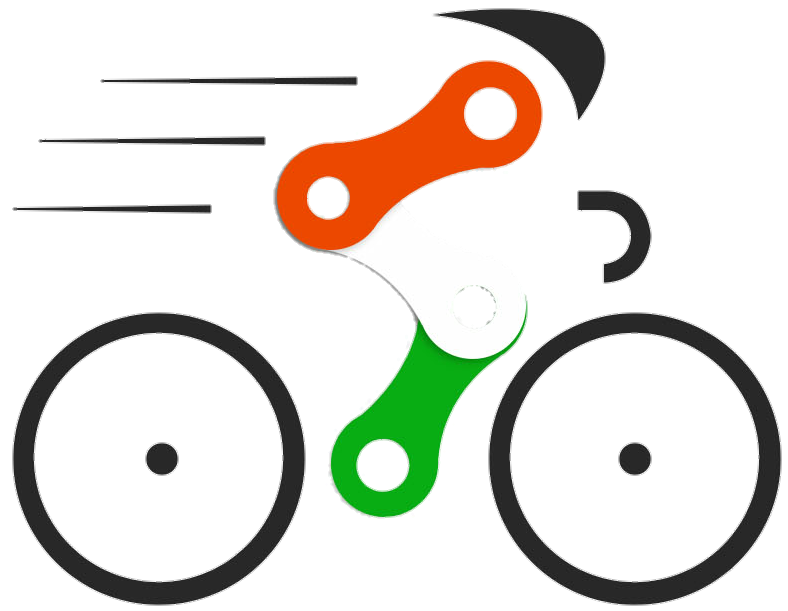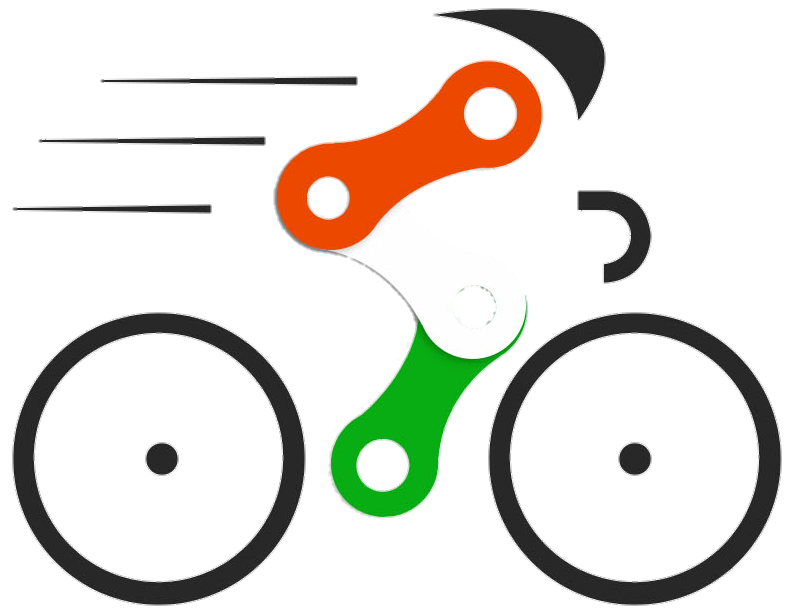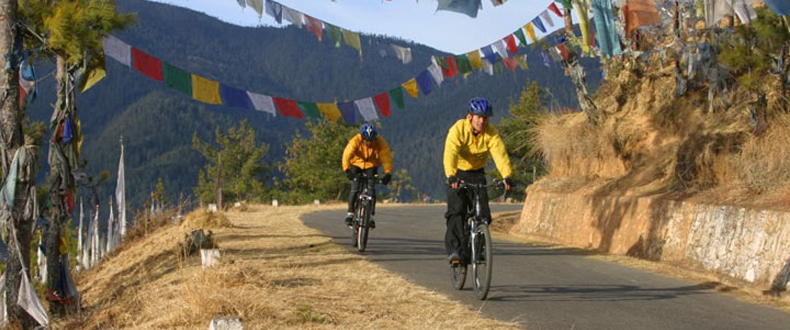
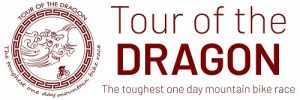
World’s toughest single-day MTB race organized by Bhutan Olympic Committee, distance – 268 km, across 4 Himalayan passes with a cumulative altitude gain of approximately 8000 m, to be completed in 16 hours. Tour of The Dragon, otherwise known as the ‘Death Race’ held in Bhutan, is an extremely difficult race that truly tests one’s physical and mental limits. Dr Mahendra Mahajan and Dr Hitendra Mahajan from Nashik participated in the race in September 2012. (http://www.tourofthedragon.com/tour-dragon/)
 Having cycled across Manali-Leh-Khardungla, the world’s highest altitude road, we were bursting with confidence. It`s then I came to know about the Tour of the Dragon race and I checked it up on the net. Reading about it, I decided that it must be experienced at least once. In the race, 268 kilometers have to be covered in a single day, and that too after crossing four passes, with a cumulative altitude gain of roughly 8000 m. This race is organized by the Bhutan Olympic Committee (BOC) and had commenced only two years earlier. In the first year, the Prince of Bhutan had participated and completed it in the specified time, which added to my zeal. Accordingly, I mailed the BOC and a few travel agents. I got a prompt response from Tenzing of Jewel Travels assuring me of sending the details for the next year’s race. In the next few months, I was preparing for the Mumbai Marathon when Tenzing mailed me that the 3rd race has been announced and registrations had begun. I asked all my cycling friends to participate with me but all declined. At last, my younger brother, Mahendra, agreed to join. We completed the registration formalities with Tenzing’s help who repeatedly asked, whether we had gone through the details of this race. Only after reaching Bhutan, we understood the intend of Tenzing repeated questions from us about the race.
Having cycled across Manali-Leh-Khardungla, the world’s highest altitude road, we were bursting with confidence. It`s then I came to know about the Tour of the Dragon race and I checked it up on the net. Reading about it, I decided that it must be experienced at least once. In the race, 268 kilometers have to be covered in a single day, and that too after crossing four passes, with a cumulative altitude gain of roughly 8000 m. This race is organized by the Bhutan Olympic Committee (BOC) and had commenced only two years earlier. In the first year, the Prince of Bhutan had participated and completed it in the specified time, which added to my zeal. Accordingly, I mailed the BOC and a few travel agents. I got a prompt response from Tenzing of Jewel Travels assuring me of sending the details for the next year’s race. In the next few months, I was preparing for the Mumbai Marathon when Tenzing mailed me that the 3rd race has been announced and registrations had begun. I asked all my cycling friends to participate with me but all declined. At last, my younger brother, Mahendra, agreed to join. We completed the registration formalities with Tenzing’s help who repeatedly asked, whether we had gone through the details of this race. Only after reaching Bhutan, we understood the intend of Tenzing repeated questions from us about the race.
 On 15th May 2012, I started my practice and calculated that since the race was 268 km at an altitude of 3400 m, having to pass four passes would be equivalent to about 300 km for we were at an altitude of 600 m. Because of my professional duties, it was possible for me to practice only on Sundays. Only thirteen Sundays were available apart from the last two for essential recuperation. Having studied the routes, only Nasik Mumbai road was found suitable; it being broad and undulating with a Ghat section between Nashik and Mumbai (Kasara Ghat). The road assistance was easily accessible if required. My brother and I started our Sunday practice session with the out and back ride to Mumbai. We started at five in the morning with LED lights to guide us and used to return by six or seven in the evening. Initially, we cycled only till Shahpur and back. On the first Sunday, we required 13 hours for 250 km. As we increased our speed to cover 300 km in 13 hours, our confidence grew. On one Sunday, we cycled directly to Wankhede stadium to watch a cricket match with my son. We were befriended by many wayside Dhabawalas who kept us informed of my brothers’ and my respective positions. One day Mahendra’s cycle got punctured five times and by the end of the day, we became experts at mending and refitting the wheels.
On 15th May 2012, I started my practice and calculated that since the race was 268 km at an altitude of 3400 m, having to pass four passes would be equivalent to about 300 km for we were at an altitude of 600 m. Because of my professional duties, it was possible for me to practice only on Sundays. Only thirteen Sundays were available apart from the last two for essential recuperation. Having studied the routes, only Nasik Mumbai road was found suitable; it being broad and undulating with a Ghat section between Nashik and Mumbai (Kasara Ghat). The road assistance was easily accessible if required. My brother and I started our Sunday practice session with the out and back ride to Mumbai. We started at five in the morning with LED lights to guide us and used to return by six or seven in the evening. Initially, we cycled only till Shahpur and back. On the first Sunday, we required 13 hours for 250 km. As we increased our speed to cover 300 km in 13 hours, our confidence grew. On one Sunday, we cycled directly to Wankhede stadium to watch a cricket match with my son. We were befriended by many wayside Dhabawalas who kept us informed of my brothers’ and my respective positions. One day Mahendra’s cycle got punctured five times and by the end of the day, we became experts at mending and refitting the wheels.
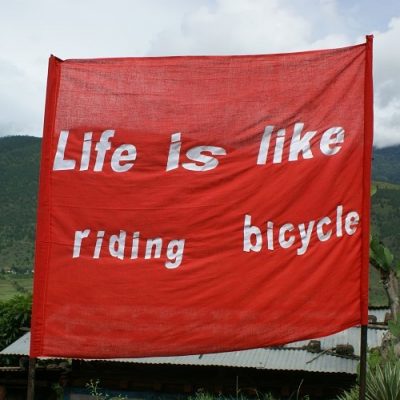 The days were hot but in time we got to enjoy the first showers. As the rains grew heavier in the Kasara Ghat sections we started getting very tired and used to return like mud men, totally encrusted with mud from head to toe. Throughout July I cannot recall having worn dry clothes or shoes. On weekdays, we practiced cycling up to Anjaneri base (a mountain 25 km away) and back home. We had brought down our time from three hours to two hours and ten minutes. With three Sundays remaining, I tripped over a speed-breaker near Kasara Ghat and ripped my right knee which required three sutures. I had to miss my practice for two weeks. We decided to take due precautions and wear knee and elbow guards, without fail. I kept on reading helpful articles like Lance Armstrong’s training. I understood the meaning of words like Cadence, also the importance of diet regulation for long-distance training. I learned how to preserve glycogen supply to the muscles and how to keep replenishing it to the required level, also what our level of lactate intolerance is and how to train our muscles to utilize fatty acids. With this knowledge and practice, our self-confidence cum excitement kept steadily increasing. We had to practice sitting on the seat and pedal continuously for 16 to 17 hours without totally exhausting the muscles at any stage. In short, it was essential to keep up the supply of glucose and carbohydrates so as to not use the stored glycogen. If the stored glycogen was used up it would require up to two weeks to come back to the original level. This is what is called “Hitting the Wall” effect. To avoid this, diet control was essential for which we decided to have chocolates, dry fruits, and G.U. Gel on the ride. These we carried in our waist pouch along with electrolyte-infused water, as we would be requiring 400 to 500 ml per hour [8 liters intake in 16 hours].
The days were hot but in time we got to enjoy the first showers. As the rains grew heavier in the Kasara Ghat sections we started getting very tired and used to return like mud men, totally encrusted with mud from head to toe. Throughout July I cannot recall having worn dry clothes or shoes. On weekdays, we practiced cycling up to Anjaneri base (a mountain 25 km away) and back home. We had brought down our time from three hours to two hours and ten minutes. With three Sundays remaining, I tripped over a speed-breaker near Kasara Ghat and ripped my right knee which required three sutures. I had to miss my practice for two weeks. We decided to take due precautions and wear knee and elbow guards, without fail. I kept on reading helpful articles like Lance Armstrong’s training. I understood the meaning of words like Cadence, also the importance of diet regulation for long-distance training. I learned how to preserve glycogen supply to the muscles and how to keep replenishing it to the required level, also what our level of lactate intolerance is and how to train our muscles to utilize fatty acids. With this knowledge and practice, our self-confidence cum excitement kept steadily increasing. We had to practice sitting on the seat and pedal continuously for 16 to 17 hours without totally exhausting the muscles at any stage. In short, it was essential to keep up the supply of glucose and carbohydrates so as to not use the stored glycogen. If the stored glycogen was used up it would require up to two weeks to come back to the original level. This is what is called “Hitting the Wall” effect. To avoid this, diet control was essential for which we decided to have chocolates, dry fruits, and G.U. Gel on the ride. These we carried in our waist pouch along with electrolyte-infused water, as we would be requiring 400 to 500 ml per hour [8 liters intake in 16 hours].
We would have been most comfortable to race the cycles we had been practicing with. The difficulty with this was that they would have to be transported by Druk Airways, the only permitted airline to Bhutan due to the mountainous terrain. Due to the limitation of free baggage the excess weight would have entailed an additional charge of Rs.55000/- each. We opted to hire old cycles at Rs.10000/- in Bhutan itself. When we got ready on 23rd August 2012 to leave, we took the Best of Luck and I Love You Papa cards made by Om, Sharanya and little Divya.
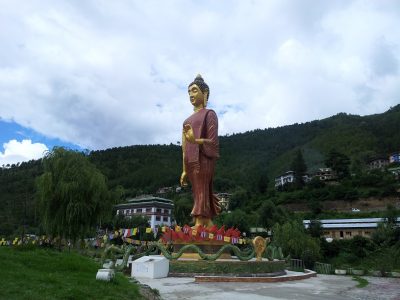 On the morning of 24th August 2012, we landed at Paro airport, a small but cute airport with Bhutanese flavor. As soon as immigration formalities were over we met our tour guide Cheemi Wangchuk and driver Namgyal and started our journey to Thimpu, the capital. We rested on that day, and on the next day, the 25th of August attended the meeting held by the Bhutan Olympic committee at the Olympic Association office. Apart from the secretary, all the other members were very young and fit, making us feel a little insecure about ourselves. We were given details about the route. We could see that we were being scrutinized by others with amusement as we had come from the plains and apart from being professional doctors we were siblings. On understanding the route we became even more diffident. We spent the afternoon visiting the main monastery [ZONG]. This tiny neighboring country is extremely beautiful and clean having a population of only seven lakhs. Most of the people are conversant with English and Hindi and regarded their King with great esteem and love. More importance is given to the Happiness Index than the GDP. This country comprises of the three M's -- Mountains, Monasteries and Monks. On the 26th of August, we saw the cycles kept for our rental and knew that a lot of alterations and repair would be necessary to make them race-worthy. After replacing the tyres we refitted the handlebars, seat covers and bottle holders--accepting that nothing more could be expected of old rented cycles. As a precautionary measure, we decided to hire a spare cycle between the two of us.
On the morning of 24th August 2012, we landed at Paro airport, a small but cute airport with Bhutanese flavor. As soon as immigration formalities were over we met our tour guide Cheemi Wangchuk and driver Namgyal and started our journey to Thimpu, the capital. We rested on that day, and on the next day, the 25th of August attended the meeting held by the Bhutan Olympic committee at the Olympic Association office. Apart from the secretary, all the other members were very young and fit, making us feel a little insecure about ourselves. We were given details about the route. We could see that we were being scrutinized by others with amusement as we had come from the plains and apart from being professional doctors we were siblings. On understanding the route we became even more diffident. We spent the afternoon visiting the main monastery [ZONG]. This tiny neighboring country is extremely beautiful and clean having a population of only seven lakhs. Most of the people are conversant with English and Hindi and regarded their King with great esteem and love. More importance is given to the Happiness Index than the GDP. This country comprises of the three M's -- Mountains, Monasteries and Monks. On the 26th of August, we saw the cycles kept for our rental and knew that a lot of alterations and repair would be necessary to make them race-worthy. After replacing the tyres we refitted the handlebars, seat covers and bottle holders--accepting that nothing more could be expected of old rented cycles. As a precautionary measure, we decided to hire a spare cycle between the two of us.
DRESS REHEARSAL
On the 27th of August, we started towards Bhumtang, the starting point of the race. To get acclimatized to the altitude, we decided to have two-hour cycling sessions for three days. We left the hotel and climbed twenty-four km to Dochula pass. I needed one hour forty minutes whereas Mahendra managed the 800 m climb in one hour thirty minutes. The 46 km downward gradient of 2000 m was unending. Continuous braking was very arduous, and the very thought of the ups and downs of the terrain was scary, to say the least, and that was the slope that we would have to ascend in the last lap of the race. After lunch, we visited the Punakha valley and carefully read through our route map. We recreated it in a graphical form, writing the names of all the villages en route. We noted which villages had feed zones and where the ambulances were positioned. We also studied how to reach the places in the allotted time zone. Our night halt on the 28th of August was Phobjika Valley. We were to see Pelela pass on the way. We decided to cycle for the first two hours. The road was very bad with bulldozers clearing landslides in many places. It was so slushy that we decided to give up after just an hour and a half as we wanted to avoid cramping. At this point, our main aim was to familiarize ourselves with the roads.
29th August: On this day we cycled from Phobjika Valley at 2800 m to Pelela pass at 3400 m. It was exhausting and took us an hour. We then mounted the cycles onto the car and started towards Trongsa which was our destination for the day. It was a straight downhill slope of 62 km which on the race day we would be climbing. After noting that, apart from the first 20 odd km the rest of the 42 km was not very steep we felt a bit relieved. We later visited the Buddhist museum and the monastery at Trongsa. That night we slept well.
 30th August: Post breakfast we proceeded by car to Jakar in Bhumtang district which was the starting point of the race. On the ride from Trongsa, we carefully looked at the pass as we would be climbing in the dark and made some notes. That day was a special one for all as we were to have a meeting with the Prince of Bhutan who was the ruling king’s younger brother. The prince graciously made us all feel at ease and he was especially curious about us because we brothers had come all the way from India, He kept emphasizing that race was not more important than our safety and well-being. Time and again he repeated this, saying that we were not accustomed to hilly regions and that we should take extra care. After the tea party, we were given our number tags and special competition T-Shirts and asked to assemble on the 1st of September at 0100 h in the morning at the Jakhar Town Square. On returning to our rooms we restudied the route maps we had made. One thing we became aware of was that, if we had to have any hope of completing the race we would have to stretch our abilities and stamina to the utmost. We could not allow any laxity in our efforts for the expected 16 to 17 hours and would have to maintain the same tempo. Now, having met the other aspirants in the race our confidence was weakening. Of the 45 contestants we two were the only Indians. The first two placed were from Nepal, two from the UK and about five or six from Germany who were settled in Bhutan for the past couple of years. Another 18 to 20 were Bhutanese contestants. Furthermore, age was in their favour as they were in their twenties. Most of them had traversed this route six or seven times for familiarization.
30th August: Post breakfast we proceeded by car to Jakar in Bhumtang district which was the starting point of the race. On the ride from Trongsa, we carefully looked at the pass as we would be climbing in the dark and made some notes. That day was a special one for all as we were to have a meeting with the Prince of Bhutan who was the ruling king’s younger brother. The prince graciously made us all feel at ease and he was especially curious about us because we brothers had come all the way from India, He kept emphasizing that race was not more important than our safety and well-being. Time and again he repeated this, saying that we were not accustomed to hilly regions and that we should take extra care. After the tea party, we were given our number tags and special competition T-Shirts and asked to assemble on the 1st of September at 0100 h in the morning at the Jakhar Town Square. On returning to our rooms we restudied the route maps we had made. One thing we became aware of was that, if we had to have any hope of completing the race we would have to stretch our abilities and stamina to the utmost. We could not allow any laxity in our efforts for the expected 16 to 17 hours and would have to maintain the same tempo. Now, having met the other aspirants in the race our confidence was weakening. Of the 45 contestants we two were the only Indians. The first two placed were from Nepal, two from the UK and about five or six from Germany who were settled in Bhutan for the past couple of years. Another 18 to 20 were Bhutanese contestants. Furthermore, age was in their favour as they were in their twenties. Most of them had traversed this route six or seven times for familiarization.
Come evening, we started arranging our paraphernalia. We felt it imprudent to carry only one liter of water and that too in the cycle bottle holder where we would have to bend every time to retrieve it. This could make us lose our balance and perhaps fall. Furthermore, a liter would not suffice and would lead to dehydration {our most dreaded enemy}. We presumed it would be better to increase our load by taking our camel pouches to carry two or three liters as it would be easier to drink directly and would need fewer refills. At every refilling, we would mix a liter of water and a liter of el1ectrolyte solution. Accordingly, we prepared our camel bag and also prepared eight 1-liter bottles of electrolyte solution for refilli11ng. To maintain our carbohydrate levels we opted to use GU Energy Gel which comes in 30 gm pouches. For having one packet every 40 minutes, we packed 22 packets in our waist pouch. For a change of taste, we carried some almond and cashew nuts. The organizers were to give us chocolates and bananas at the feed zones.
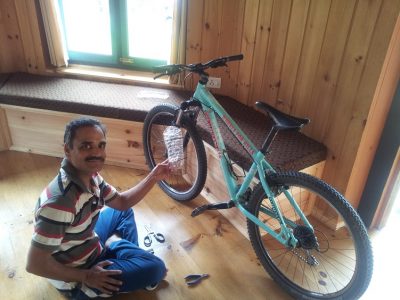 Now we turned our attention to our cycles. Having checked the chain, brakes, gear. the pump and tool kit as well as the puncture kit we affixed the number plates allotted to us. At this point, we noted the lack of mud flaps. Although some contestants avoid them to reduce the weight it is safer to have them as they prevent mud from the fore wheels spraying and blinding the cyclist. Rear mud flaps, we felt, were not required as at worst our backs would be muddied. We would be unable to get the mud flaps at such short notice but fortunately for us, a participant from the UK suggested using flattened empty water bottles modified to be used as mud flaps. Accordingly, we flattened mineral water plastic bottles and attached them to the diagonal bar of the cycle frames wherein the weight increase was negligible. Having prepared the bikes to our satisfaction, we turned our attention to the standby cycle we were to carry. The bike’s condition was not only miserable, it was size 15” and the old tyres were larger which would add to the friction and effort. Anyway, we lubricated it and hoped that the standby would not be required. That day we hardly ate. To avoid calls of nature we decided to eat high energy, low volume and liquid food. We realized that extreme exertion would slow down our digestion process.
Now we turned our attention to our cycles. Having checked the chain, brakes, gear. the pump and tool kit as well as the puncture kit we affixed the number plates allotted to us. At this point, we noted the lack of mud flaps. Although some contestants avoid them to reduce the weight it is safer to have them as they prevent mud from the fore wheels spraying and blinding the cyclist. Rear mud flaps, we felt, were not required as at worst our backs would be muddied. We would be unable to get the mud flaps at such short notice but fortunately for us, a participant from the UK suggested using flattened empty water bottles modified to be used as mud flaps. Accordingly, we flattened mineral water plastic bottles and attached them to the diagonal bar of the cycle frames wherein the weight increase was negligible. Having prepared the bikes to our satisfaction, we turned our attention to the standby cycle we were to carry. The bike’s condition was not only miserable, it was size 15” and the old tyres were larger which would add to the friction and effort. Anyway, we lubricated it and hoped that the standby would not be required. That day we hardly ate. To avoid calls of nature we decided to eat high energy, low volume and liquid food. We realized that extreme exertion would slow down our digestion process.
On August 31, we did not have much preparation to go through so we visited religious places and went to the oldest temple. We tried in vain to take a nap but though sleep eluded us we continue to rest in bed to be fresh for the midnight race. Both of us were fraught with worries and doubts. Would we be able to complete the course? Would we be able to accomplish the 160-kilometer climb and the 110-kilometer downward gradient safely? Even a puncture would be an arduous task to repair in the cold apart from the loss of time. We did not have even a half hour to spare to finish the race in the prescribed time. If there were to be any untoward mishap or breakdown the race would be as good as over for us, destroying our hopes, efforts over the past five months, money spent as also the expectations of our family and well-wishers. I had to keep on praying, motivating and convincing myself that God helps those who help themselves.
When the alarm went off at midnight we jumped out of bed and with a pot of coffee managed to complete our morning rituals. We donned our cycling apparel, and keeping safety in mind wore our protective knee guards, elbow guards and jackets. We fixed our headlamps and then turned our attention to Cheemi Wangchook, who over time had won our hearts and confidence and had become our friend more than our tour guide. On seeing our enthusiasm and efforts he had started believing in our ability to complete the task ahead. We rehearsed once again the manner in which he was to dispense our bottles during the race. We also kept a spare set of clothes with him and then made for the starting point, about two kilometers away from our hotel.
THE START
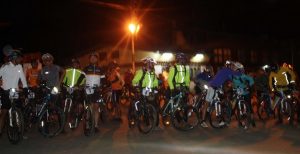 At 0100 h the place was thronging with spectators. The participants were excited, full of hope and battle-ready. Everyone was checking their cycles and equipment, confirming that they met the specified requirements as only then were the organizers affixing the OK stickers. In the square was the direction board showing that Thimphu was 268 km away. After consuming tea and sandwiches, which the organizers had provided, we rechecked our cycle lights and headlamps. 25 cars had been earmarked for the 45 participants. These were essentials for each cyclist and there was to be a marshal in each car to see that rules were being observed. It was the marshals’ duty to certify that a damaged cycle was beyond repair and could therefore be replaced. When we were introduced to our marshal, he said, “Doctor this is not the only thing you will be doing in your life,” conveying to us that there was no need to take unnecessary risks.
At 0100 h the place was thronging with spectators. The participants were excited, full of hope and battle-ready. Everyone was checking their cycles and equipment, confirming that they met the specified requirements as only then were the organizers affixing the OK stickers. In the square was the direction board showing that Thimphu was 268 km away. After consuming tea and sandwiches, which the organizers had provided, we rechecked our cycle lights and headlamps. 25 cars had been earmarked for the 45 participants. These were essentials for each cyclist and there was to be a marshal in each car to see that rules were being observed. It was the marshals’ duty to certify that a damaged cycle was beyond repair and could therefore be replaced. When we were introduced to our marshal, he said, “Doctor this is not the only thing you will be doing in your life,” conveying to us that there was no need to take unnecessary risks.
At 0130 h, we were asked to align for the start. The other participants were in their twenties and looked fit. The professional get-up with their advanced 8500 Trek bikes and cycling shorts. They were carrying only a single water bottle as opposed to us who were in full cycling clothes. We were also wearing knee and elbow guards and carried the additional weight of a full camel pouch of water on our backs. The other cyclists were having more professional outlook as they had come with the intention of winning or at least bettering their previous efforts and timing, whereas we were amateurs and our sole aim was to try and complete the race safely within the prescribed time.
 Twenty minutes were remaining for the race to start. The Prince himself was astride a cycle. He wished us all and again reiterated the aspect of safety. In this last half hour, we had to visit the bathroom thrice because of the weather and noticed we were not the only ones to do so. I hugged my brother and told him not to worry about me and to go ahead at his own full pace. As ten seconds remained, the countdown started. As soon as the starting gun went off, we all shot off. In the dark, our headlights looked like a swarm of fireflies. Ten kilometers ahead would be Kikila Pass that we had to reach before 0300 h. Because of a sparse cloud cover, we had the benefit of the full moon peeping through at times. Mahendra had shot ahead of me as I managed the pass at 0240 h. Many bikers had gone ahead of me but there were quite a few behind me, which was heartening. After KikiLa was a downhill ride of about 05 km after which an 8 % upward gradient was to be negotiated. Our support vehicles were nearby. Because of settlements along the way we had to be wary of slippery dung heaps which were noticed only at the last moment. Even more difficult was to negotiate the cows squatting on the road, discernable only by their eyes that shone in the dark. There were several near misses!
Twenty minutes were remaining for the race to start. The Prince himself was astride a cycle. He wished us all and again reiterated the aspect of safety. In this last half hour, we had to visit the bathroom thrice because of the weather and noticed we were not the only ones to do so. I hugged my brother and told him not to worry about me and to go ahead at his own full pace. As ten seconds remained, the countdown started. As soon as the starting gun went off, we all shot off. In the dark, our headlights looked like a swarm of fireflies. Ten kilometers ahead would be Kikila Pass that we had to reach before 0300 h. Because of a sparse cloud cover, we had the benefit of the full moon peeping through at times. Mahendra had shot ahead of me as I managed the pass at 0240 h. Many bikers had gone ahead of me but there were quite a few behind me, which was heartening. After KikiLa was a downhill ride of about 05 km after which an 8 % upward gradient was to be negotiated. Our support vehicles were nearby. Because of settlements along the way we had to be wary of slippery dung heaps which were noticed only at the last moment. Even more difficult was to negotiate the cows squatting on the road, discernable only by their eyes that shone in the dark. There were several near misses!
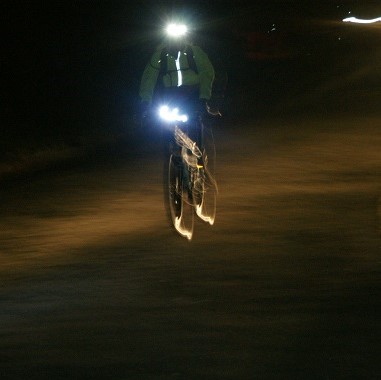 Thimphu city lay 260 km ahead. We hardly noticed the first 20 km climb as it was quite easy. The next incline was at 15-25 degrees for about 20 km and it would ultimately take us to Yotang Pass (3450 m) which was the highest. At this stage, I was passing some cyclists and was being passed by others. I was using the 2-4 and 2-3 gear combinations. The morning freshness helped me to avoid using the first gear. I reached Yotang in darkness. It was comforting to see Stupas en route. Having reached Yotang, as planned at 0500 h, I began to grow into cautious optimism about my chances. I decided not to stop at Yotang but to continue. The next 50 km stretch was flat till Trongsa after which it was downhill till Bijizham. Zam means a bridge across a river and once we start going into a valley we know that we would reach a river.
Thimphu city lay 260 km ahead. We hardly noticed the first 20 km climb as it was quite easy. The next incline was at 15-25 degrees for about 20 km and it would ultimately take us to Yotang Pass (3450 m) which was the highest. At this stage, I was passing some cyclists and was being passed by others. I was using the 2-4 and 2-3 gear combinations. The morning freshness helped me to avoid using the first gear. I reached Yotang in darkness. It was comforting to see Stupas en route. Having reached Yotang, as planned at 0500 h, I began to grow into cautious optimism about my chances. I decided not to stop at Yotang but to continue. The next 50 km stretch was flat till Trongsa after which it was downhill till Bijizham. Zam means a bridge across a river and once we start going into a valley we know that we would reach a river.
A lot of accidents had occurred in this area in the last two competitions. We had been warned about this and the organizers had allotted extra cars. After four hours our torches started dimming, and a car was used to follow the leaders to illuminate the road ahead. Even though it was five in the morning, it was dark and there was a complete cloud cover over the valley, and we were literally riding the clouds. When I began going down I saw a crowd about 100 m ahead. I was sure it was Mahendra by the colour of his cycle. Reaching there, I saw that his cycle chain had become inextricably entangled. He assured me that everything was fine and I should go ahead. I continued. If we are hasty in changing gears a sudden slack in the chain causes entanglement. Mahendra was ahead of me by about half an hour but now he had lost a lot of time. On seeing the condition of his cycle the marshals allowed him to replace it with the spare one.
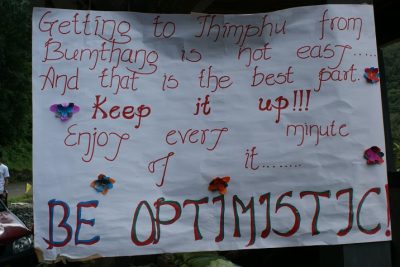 Within three to four km, Mahendra overtook me with gusto. I felt the slope was unending. The weather seemed foggy and the visibility was very poor. On one side were the mountains and unprotected sheer drops of over 1000 m on the other. The thought of what could happen if the brakes failed and I were to go down unknown to the others was scary, to say the least. This made me slow down somewhat. I tried to keep to the right, away from the valley side. The 50 km downslope seemed unending. It had also become colder and my hands started feeling numb, making braking more difficult. As I came further down the slope, the clouds started thinning and I could see Trongsa town ahead. Crossing Trongsa, after negotiating a speed breaker, which had caused a participant, the previous year, to fracture his jaw in a fall, I reached Bijizam. Bijizam is at an altitude of 1200 meters which meant that I had come down 2300 meters and reached at the decided time of 0600 h.
Within three to four km, Mahendra overtook me with gusto. I felt the slope was unending. The weather seemed foggy and the visibility was very poor. On one side were the mountains and unprotected sheer drops of over 1000 m on the other. The thought of what could happen if the brakes failed and I were to go down unknown to the others was scary, to say the least. This made me slow down somewhat. I tried to keep to the right, away from the valley side. The 50 km downslope seemed unending. It had also become colder and my hands started feeling numb, making braking more difficult. As I came further down the slope, the clouds started thinning and I could see Trongsa town ahead. Crossing Trongsa, after negotiating a speed breaker, which had caused a participant, the previous year, to fracture his jaw in a fall, I reached Bijizam. Bijizam is at an altitude of 1200 meters which meant that I had come down 2300 meters and reached at the decided time of 0600 h.
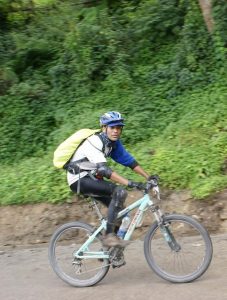 The next lap was 62 km uphill before reaching Pelela. It had started drizzling and I wanted to reach Pelela by 0700 h, as only then would I have sufficient time to negotiate Dochula pass at 3300 m. It was obligatory to cross this 60 km stretch before 6 in the evening. This was disturbing, but having been able to keep the timing till now I started pedaling faster. Six kilometers ahead was the second feed zone at Trongsa viewpoint. I reached there at 0700 h and decided to alight after my five-hour stint. Cheemi was waiting. People were waiting to offer peeled bananas and unwrapped chocolates. Cheemi filled my camel pouch with a liter of water and a bottle of electrolyte solution. Meanwhile, I helped myself to a couple of bananas and five chocolates. Mahendra had already gone ahead. Cheemi also left to help Mahendra and to be there at the next feed zone. It was surprising how close we had become to a stranger whom we had met just a few days back. Cheemi was our pillar of support.
The next lap was 62 km uphill before reaching Pelela. It had started drizzling and I wanted to reach Pelela by 0700 h, as only then would I have sufficient time to negotiate Dochula pass at 3300 m. It was obligatory to cross this 60 km stretch before 6 in the evening. This was disturbing, but having been able to keep the timing till now I started pedaling faster. Six kilometers ahead was the second feed zone at Trongsa viewpoint. I reached there at 0700 h and decided to alight after my five-hour stint. Cheemi was waiting. People were waiting to offer peeled bananas and unwrapped chocolates. Cheemi filled my camel pouch with a liter of water and a bottle of electrolyte solution. Meanwhile, I helped myself to a couple of bananas and five chocolates. Mahendra had already gone ahead. Cheemi also left to help Mahendra and to be there at the next feed zone. It was surprising how close we had become to a stranger whom we had met just a few days back. Cheemi was our pillar of support.
It now began to pour and I got soaked through my windcheater but I was not cold as I was climbing up. The last 20 Km. to Palela pass was a very steep climb and worrisome. But having been able to keep to the schedule till now was reassuring. Then suddenly the prince cycled abreast and chatted with me. He seemed intrigued by the fact that we brothers had come from so far away and that too without having any experience or practice in similar terrain and altitude. He then left me to converse with the others after reminding me, once again, to show respect to the aspect of safety.
It was around 0930 h and about 15-16 kilometers to Palela pass. I was getting a bit tired and cold as I was approaching 3200 meters. Occasionally, I got a glimpse of another competitor. This did not bother me as I was not racing them but racing against time. I had to pass Dochula pass before six in the evening after which 20 Km. to Thimphu was downhill which would be easy. I could not gauge how far Palela was as the visibility was poor. It was nearing 10.30 and it was essential to cross Palela before 11. Fifteen minutes later I came to the last bend and through the clouds saw the Stupa on Palela. Cheemi and the marshal were waiting for me in the rain. They told me that Mahendra had passed forty minutes or so earlier. I got off, comforted with the thought that I had covered a 62-kilometer road and 2000 meters height in three hours and forty-five minutes. Taking Cheemi’s advice I exchanged my soaked shirt for a dry one. In spite of donning the windcheater, I was unable to stop shivering. Cheemi refilled my camel pouch with water and the electrolyte solutions while I hastily ate two bananas and a bar of chocolate. Within five minutes I was astride.
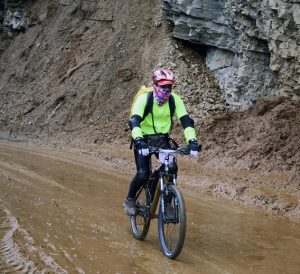 Ahead was a slope of about 50 km, but the road was very bad. On the right was the valley and the road was not only untarred but also full of potholes, stones and mud. For our sake, the maintenance crew had stopped their bulldozers and work. Climbing uphill the body had generated heat. While going down now the speed had increased and also air flow, added to this was the continuous downpour. I was chilled to the bone, shivering violently and doubted that I would even be able to brake when needed. I was sure that I was heading for a fall. So I got off my bike and jumped about praying for sunshine. Then telling myself that this would be the last spell of cold I mounted my bike again. Time was running out, my limbs were numb and I could see no one around me. Our escort car had gone ahead to replenish Mahendra’s water. I started feeling very lonely. But at last, I reached Teki Gompa where the downward slope ended. It was less cold there and I could dwellings and a few people. Half an hour had been lost in this stretch. Instead of reaching at 1210 h, I had reached at 1130 h.
Ahead was a slope of about 50 km, but the road was very bad. On the right was the valley and the road was not only untarred but also full of potholes, stones and mud. For our sake, the maintenance crew had stopped their bulldozers and work. Climbing uphill the body had generated heat. While going down now the speed had increased and also air flow, added to this was the continuous downpour. I was chilled to the bone, shivering violently and doubted that I would even be able to brake when needed. I was sure that I was heading for a fall. So I got off my bike and jumped about praying for sunshine. Then telling myself that this would be the last spell of cold I mounted my bike again. Time was running out, my limbs were numb and I could see no one around me. Our escort car had gone ahead to replenish Mahendra’s water. I started feeling very lonely. But at last, I reached Teki Gompa where the downward slope ended. It was less cold there and I could dwellings and a few people. Half an hour had been lost in this stretch. Instead of reaching at 1210 h, I had reached at 1130 h.
The next 12 km stretch was on level ground. This was called our rolling road. The wind was against me but with renewed enthusiasm, I continued. Here, I met Cheemi and handed over my wet gloves and replenished my water. I felt nauseated having had G.U. Gel every forty minutes since 2 a.m. But my muscles needed this energy so I set an alarm on my watch which prompted me to swallow the Gel and follow it with a gulp of water. I, thus reached Wangdu Fodrang. From there a climb of 46 Km. would begin. This was at an incline of 15 to 25 degrees and 2000 meters altitude had to be gained by six in the evening. Thus, I had four hours and forty minutes at my disposal.. It was 1.20 now and I had been astride for eleven hours and forty minutes after having covered 200Km. and crossed three passes. I noticed many vehicles, in the last 20Km. ferrying participants and their cycles. These were those who had given up.
 The goal ahead, though difficult, seemed surmountable. Convincing myself that now only another practice like a session of Anjaneri or Kasara remained, I started pedaling furiously. I kept on motivating myself as if I only had to cross Khardungla for one more time. Mahendra would have been about 45 minutes ahead, realized he would cross Dochula pass in time. This reassured me. Lobetsa was the next feed zone where I refilled water and hurriedly ate another chocolate. After encouraging me, Cheemi went towards Mahendra. With the increasing slope, riding in 2-2/1 gear was becoming difficult and I had to shift to 1-3 and 1-2 gear. On many curves, I had no option but to use the 1-1 gear. This portion of the route had the most traffic. Vehicles were zooming past in both directions. Cheemi had cautioned me about this as the oncoming vehicles suddenly veered to avoid bad patches in the road, and sharp turns caused them to loom unexpectedly in front of me. In spite of this, my focus was only on reaching Dochula before six. Having done this stretch during familiarization I pedaled furiously. About an hour later I had another Gel and water. I was now finding 1-2 difficult but coming down to 1-1 was slowing me down. Hence I decided to continue with 1-2 or, wherever possible 1-3 gear to gain speed. Since there were no milestones I had no idea of how many kilometers of the 46 km were remaining I had traveled. Because of the language barrier, I was unable to get proper answers from the bystanders. I estimated that about 36 Km. were remaining.
The goal ahead, though difficult, seemed surmountable. Convincing myself that now only another practice like a session of Anjaneri or Kasara remained, I started pedaling furiously. I kept on motivating myself as if I only had to cross Khardungla for one more time. Mahendra would have been about 45 minutes ahead, realized he would cross Dochula pass in time. This reassured me. Lobetsa was the next feed zone where I refilled water and hurriedly ate another chocolate. After encouraging me, Cheemi went towards Mahendra. With the increasing slope, riding in 2-2/1 gear was becoming difficult and I had to shift to 1-3 and 1-2 gear. On many curves, I had no option but to use the 1-1 gear. This portion of the route had the most traffic. Vehicles were zooming past in both directions. Cheemi had cautioned me about this as the oncoming vehicles suddenly veered to avoid bad patches in the road, and sharp turns caused them to loom unexpectedly in front of me. In spite of this, my focus was only on reaching Dochula before six. Having done this stretch during familiarization I pedaled furiously. About an hour later I had another Gel and water. I was now finding 1-2 difficult but coming down to 1-1 was slowing me down. Hence I decided to continue with 1-2 or, wherever possible 1-3 gear to gain speed. Since there were no milestones I had no idea of how many kilometers of the 46 km were remaining I had traveled. Because of the language barrier, I was unable to get proper answers from the bystanders. I estimated that about 36 Km. were remaining.
I was aware that I was tiring but my mind refused to accept it. I could only think about increasing my speed from 10 to 12 Km. per hour. I had only three and a half hours left to cover 36 Km. At times, I felt I could reach even by 5.30 but I did not want to take a chance to save 10-15 minutes. Coming down to Pelela in the cold had taken extra time and this half an hour could cost me dear. I was attempting to avoid pessimistic thoughts. Vehicles carrying participants who had given up the race because of fatigue and the cold started passing me. They tried to cheer me on but I barely had the energy to acknowledge them with a nod or so. Seeing them, I felt that the 220 Km. I had achieved was good enough and wondered whether I should give up. Then brushing these thoughts aside I stuck to my task.
Time was flying. It was 4.30 and I had no idea of how much further I had to go. I kept on hoping that the next curve would bring Dochula pass into view. But in vain. Curve after curve passed without respite. About 10 Km. before Dochula was a feed zone where Cheemi was to wait for me but at 5 pm I still had not reached my destination. I started pedaling furiously and at the next bend, I saw the feed zone. I had nearly exhausted my stock of water. Ten kilometers remained with only forty minutes to expend. I needed the water but did not have the few minutes needed to spare. I asked Cheemi to hand me a bottle from which I drank on the go and kept it in the bottle holder. I did not get off the cycle because I realized that if I got down, I would not have been able to get astride again. Breaking the motion of my legs could invariably lead to my getting cramps. I felt that to go 10 Km. in forty minutes was a formidable task. The Marshall also doubted that I’d be able to reach Dochula by six. I ignored him and decided not to get off the cycle before six-under any circumstances.
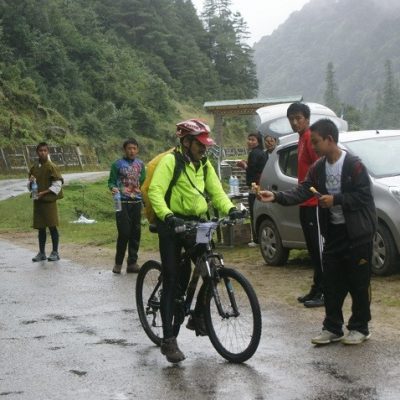 I started going back in time. The 4-5 months of practice through sun and rain, the trips to Mumbai, the encouraging Dhabawalas and the months of neglect I inflicted on my wife and children which they bore with fortitude while continuing to encourage me. How could I forget my friends who kept a track of me till the last, of those who helped me with the hired cycles, of my children who had wished me all the best? Cheemi and the driver and the effort and encouragement that they offered could not be taken lightly either. I would not let all this go in vain, and keeping that in mind started pedaling harder.
I started going back in time. The 4-5 months of practice through sun and rain, the trips to Mumbai, the encouraging Dhabawalas and the months of neglect I inflicted on my wife and children which they bore with fortitude while continuing to encourage me. How could I forget my friends who kept a track of me till the last, of those who helped me with the hired cycles, of my children who had wished me all the best? Cheemi and the driver and the effort and encouragement that they offered could not be taken lightly either. I would not let all this go in vain, and keeping that in mind started pedaling harder.
With fifteen minutes remaining and 5-6 km still to go, I noticed the Olympic Committee’s backup van approaching as if it was waiting to pounce and pick me up. The last Stupa was visible and with a heavy heart, I realized that I would not be able to complete the race in time because of the last 3-4 Km. Behind me was another cyclist but no one else was in sight. The others had either passed Dochula earlier or had given up and had been whisked away. How wonderful it would have been if the organizers had extended the time by fifteen minutes or so considering the inclement weather conditions. This was merely a dream. After all, The Bhutan Olympic Committee had organized this race in accordance with international standards and the race was not called Death Race for anything. I too, would not have been proud to complete the race with a grace period.
The race marshal and the backup van started closing in on me. The final ten minutes remained with 5 to 6 km to go. I was still reluctant to give up and as a last resort threw the bag off my back to lighten me further. I covered another 2.5 km but then, the Marshal drew abreast and said, “Time up, doctor”. It was the final straw.  I could no longer control myself. I sat on the road started sobbing inconsolably. I had lost for the lack of just fifteen minutes. Never in my life, had I forced myself mentally or physically to this extent. What I got in return was the satisfaction of having done the best I could. I took solace in the knowledge that Mahendra had successfully completed the race. When Cheemi saw me break down and cry, he was nonplussed. He said “You should be proud of yourself, Doctor. More than half of the participants had quit the race because of the cold long ago. Of the 45 contestants till now, you are the 17th and behind you is the 18th. Only 16 have successfully completed the race in the given time.” In spite of Cheemi’s consolation, I was unable to bear the sorrow. I did not have the strength to hold my cycle and stand. Four weeks prior to the race I had taken a fall in the Kasara ghat. I was badly bruised and needed three stitches on the knee. This had forced me to miss out on proper practice. The fine weather in Bhutan for the past five days had changed to a downpour today. All these were excuses, which do not befit a sportsman to put forth. I had to acknowledge that I could not complete the race in the given time, and this fact remained. To accept such defeats or setbacks is what had been tutored into us during our Himalayan and Sahyadri trekking and cycling endeavors.
I could no longer control myself. I sat on the road started sobbing inconsolably. I had lost for the lack of just fifteen minutes. Never in my life, had I forced myself mentally or physically to this extent. What I got in return was the satisfaction of having done the best I could. I took solace in the knowledge that Mahendra had successfully completed the race. When Cheemi saw me break down and cry, he was nonplussed. He said “You should be proud of yourself, Doctor. More than half of the participants had quit the race because of the cold long ago. Of the 45 contestants till now, you are the 17th and behind you is the 18th. Only 16 have successfully completed the race in the given time.” In spite of Cheemi’s consolation, I was unable to bear the sorrow. I did not have the strength to hold my cycle and stand. Four weeks prior to the race I had taken a fall in the Kasara ghat. I was badly bruised and needed three stitches on the knee. This had forced me to miss out on proper practice. The fine weather in Bhutan for the past five days had changed to a downpour today. All these were excuses, which do not befit a sportsman to put forth. I had to acknowledge that I could not complete the race in the given time, and this fact remained. To accept such defeats or setbacks is what had been tutored into us during our Himalayan and Sahyadri trekking and cycling endeavors.
At 6:27 Mahendra had reached the cock tower at Thomphu, which was the finishing line. The prize-giving ceremony was scheduled for seven. We went to a nearby hotel, cleaned up and proceeded for the ceremony. It was a proud moment when we realized that we were the first Indians to take part in this prestigious international race in the open category, rightly called THE DEATH RACE. 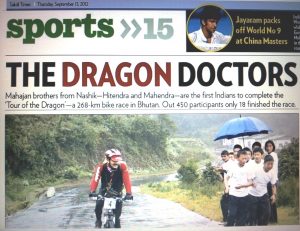 As per custom only the first ten in the finishing order were invited on the stage and were awarded certificates. Sonam Namgyal finished the race in eleven hrs. Last year's timing for the same was eleven and a half hours. He was given a prize of one lakh. The runner-up was the winner in the first edition of the Death Race, and the third-placed was an official in the environmental department. The fourth-placed was a leader of the opposition. It was surprising to see these facets of the polity. Thereafter, was dinner with the Prince of Bhutan. The Prince told us that he really did not expect that we would be able to finish the race and invited us to return for the next year's race. The rest of the participants who had completed the race were given certificates of merit. 16 had managed to complete the course and my brother, Mahendra was the 15th to do so in sixteen hours and twenty-seven minutes. Everyone was tired but was eager to know about the others. Finally, after thanking the Prince and the organizers for the excellent management we departed. That night, I found it difficult to fall asleep in spite of the fatigue. Even a painkiller and a sedative tablet could not rid me of the aches and pains. I was reliving the trauma and anxiety of the seventeen hours trauma. At home, after a strenuous session, my son and wife used to comfort me and ease away the fatigue. Amidst these thoughts, I fell asleep.
As per custom only the first ten in the finishing order were invited on the stage and were awarded certificates. Sonam Namgyal finished the race in eleven hrs. Last year's timing for the same was eleven and a half hours. He was given a prize of one lakh. The runner-up was the winner in the first edition of the Death Race, and the third-placed was an official in the environmental department. The fourth-placed was a leader of the opposition. It was surprising to see these facets of the polity. Thereafter, was dinner with the Prince of Bhutan. The Prince told us that he really did not expect that we would be able to finish the race and invited us to return for the next year's race. The rest of the participants who had completed the race were given certificates of merit. 16 had managed to complete the course and my brother, Mahendra was the 15th to do so in sixteen hours and twenty-seven minutes. Everyone was tired but was eager to know about the others. Finally, after thanking the Prince and the organizers for the excellent management we departed. That night, I found it difficult to fall asleep in spite of the fatigue. Even a painkiller and a sedative tablet could not rid me of the aches and pains. I was reliving the trauma and anxiety of the seventeen hours trauma. At home, after a strenuous session, my son and wife used to comfort me and ease away the fatigue. Amidst these thoughts, I fell asleep.
We woke up late the next day. Cheemi escorted us to a specialty restaurant for lunch. We treated Cheemi and our driver, Namgyal with a lavish lunch and expressed our heartfelt thanks. We spent the evening ambling through the market. We had to report to the airport at five in the morning. Now the urge to go home was overpowering. After all, what is better than home?
About the Author
Dr Hitendra Mahajan is MD (Anesthesiologist) by qualification and was of 41 years when he did this race.  During his graduation (MBBS from BJ Medical College, Pune in 1988), he was inclined to trekking around Pune in Sahyadri/Western Ghats. In 1989, he went to Manali and did a course in Basic Mountaineering (A-Grade). Later he climbed many pinnacles in Sahyadri like Duke's nose, Khada Pharshi, Tale Bailya, etc. In 1992, he completed Advanced Mountaineering Course, NIMS, Nainital and later did Mount Kedardome Expedition in 1993. He rekindled his trekking passion from 2000 to 2008 by doing High Altitude Himalayan treks. From 2008, he started running Mumbai Marathon (42km) every year and started cycling as well. They were winners at Enduro 3, a pentathlon endurance race in the Amateur category and later in the Open category. In the year 2011, he cycled Manali-Leh-KhardungLa. Post attempting the Tour of Dragon race in 2012, he won the Race Across America 2015 (Team of 2 category), successfully finished Tour of Dragon in 2017 and climbed Mt Everest in 2019.
During his graduation (MBBS from BJ Medical College, Pune in 1988), he was inclined to trekking around Pune in Sahyadri/Western Ghats. In 1989, he went to Manali and did a course in Basic Mountaineering (A-Grade). Later he climbed many pinnacles in Sahyadri like Duke's nose, Khada Pharshi, Tale Bailya, etc. In 1992, he completed Advanced Mountaineering Course, NIMS, Nainital and later did Mount Kedardome Expedition in 1993. He rekindled his trekking passion from 2000 to 2008 by doing High Altitude Himalayan treks. From 2008, he started running Mumbai Marathon (42km) every year and started cycling as well. They were winners at Enduro 3, a pentathlon endurance race in the Amateur category and later in the Open category. In the year 2011, he cycled Manali-Leh-KhardungLa. Post attempting the Tour of Dragon race in 2012, he won the Race Across America 2015 (Team of 2 category), successfully finished Tour of Dragon in 2017 and climbed Mt Everest in 2019.
